A carbine, from French carabine, is a long gun firearm but with a shorter barrel than a standard rifle or musket. Many carbines are shortened versions of full-length rifles, shooting the same ammunition, while others fire lower-powered ammunition, including types designed for pistols.

A machine gun is a fully automatic mounted or portable firearm designed to fire rifle cartridges in rapid succession from an ammunition belt or magazine. Not all fully automatic firearms are machine guns. Submachine guns, rifles, assault rifles, battle rifles, shotguns, pistols or cannons may be capable of fully automatic fire, but are not designed for sustained fire. As a class of military rapid-fire guns, machine guns are fully automatic weapons designed to be used as support weapons and generally used when attached to a mount or fired from the ground on a bipod or tripod. Many machine guns also use belt feeding and open bolt operation, features not normally found on rifles.

A submachine gun, abbreviated SMG, is a magazine-fed, automatic carbine designed to shoot handgun cartridges. The term "submachine gun" was coined by John T. Thompson, the inventor of the Thompson submachine gun.

The Thompson submachine gun is an American submachine gun invented by John T. Thompson in 1918 which became infamous during the Prohibition era, being a signature weapon of various organized crime syndicates in the United States. It was a common sight in the media of the time, being used by both law enforcement officers and criminals. The Thompson submachine gun was also known informally as the "Tommy Gun", "Tôm Sông", "Annihilator", "Chicago Typewriter", “TrenchBroom”, "Chicago Submachine", "Chicago Piano", "Chicago Style", "Chicago Organ Grinder", "Drum Gun","The Chopper", and simply "The Thompson".

The Lee–Enfield is a bolt-action, magazine-fed, repeating rifle that served as the main firearm used by the military forces of the British Empire and Commonwealth during the first half of the 20th century. It was the British Army's standard rifle from its official adoption in 1895 until 1957. The WWI versions are often referred to as the "SMLE", which is short for the common "Short, Magazine Lee–Enfield" variant.

The M1 carbine is a lightweight, easy to use, .30 carbine semi-automatic carbine that was a standard firearm for the U.S. military during World War II, the Korean War and well into the Vietnam War. The M1 carbine was produced in several variants and was widely used by not only the U.S. military, but by paramilitary and police forces around the world. It has also been a popular civilian firearm.
The STEN was a family of British submachine guns chambered in 9×19mm and used extensively by British and Commonwealth forces throughout World War II and the Korean War. They had a simple design and very low production cost, so they were also effective insurgency weapons for resistance groups.

The De Lisle carbine or De Lisle Commando carbine was a British firearm used during World War II that was designed with an integrated suppressor. That, combined with its use of subsonic ammunition, made it extremely quiet in action, possibly one of the quietest firearms ever made.
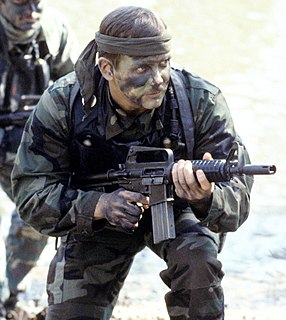
The Colt Automatic Rifle-15 or CAR-15 was a family of M16 rifle based firearms marketed by Colt in the 1960s and early 1970s. However, the term "CAR-15" is most commonly associated with the Colt Commando(AKA: XM177); these select-fire carbines have ultrashort 10.5-inch (270 mm) and 11.5-inch (290 mm) barrels with over-sized flash suppressors.

The Sterling submachine gun is a British submachine gun. It was tested with the British Army in 1944–1945 as a replacement for the Sten but it did not start to replace it until 1953. A successful and reliable design, it remained as standard issue with the British Army until 1994, when it was phased out as the L85A1 assault rifle was phased in.
Blowback is a system of operation for self-loading firearms that obtains energy from the motion of the cartridge case as it is pushed to the rear by expanding gas created by the ignition of the propellant charge.

The Błyskawica, was a submachine gun produced by the Armia Krajowa, or Home Army, a Polish resistance movement fighting the Germans in occupied Poland. Together with a Polish version of the Sten sub-machine gun, with which it shares some design elements, it was the only weapon mass-produced covertly in occupied Europe during World War II.
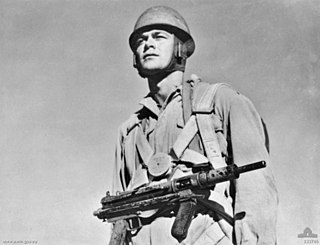
The Austen was a 9×19mm Australian submachine gun derived from the British Sten gun developed during the Second World War. In total 19,914 Austens were produced during the war by Diecasters Ltd of Melbourne and W. T. Carmichael Ltd of Sydney.
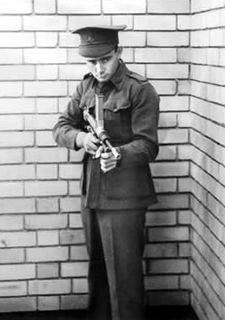
Evelyn Ernest Owen was an Australian who developed the Owen submachine gun which was used by the Australian Army in World War II, the Korean War and the Vietnam War.
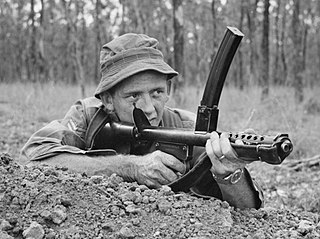
The 9×19mm Parabellum F1 was a standard Australian submachine gun manufactured by the Lithgow Small Arms Factory. First issued to Australian troops in July 1963, it replaced the Owen machine carbine.

The M3 is an American .45-caliber submachine gun adopted for U.S. Army service on 12 December 1942, as the United States Submachine Gun, Cal. .45, M3. The M3 was chambered for the same .45 ACP round fired by the Thompson submachine gun, but was cheaper to produce and lighter, although, contrary to popular belief, it was less accurate. This myth stems from a US Army training film portraying the M3 as more accurate than its counterparts. The M3 was commonly referred to as the "Grease Gun" or simply "the Greaser," owing to its visual similarity to the mechanic's tool.
The M1944 Hyde Carbine was an attempt by George Hyde to manufacture a light rifle for the US Armed Forces. The overall weapon was based on the Thompson Submachine Gun which Hyde himself designed many of his weapons on.
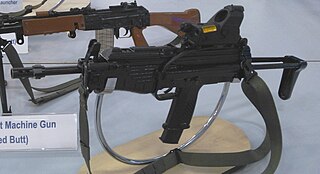
The Joint Venture Protective Carbine (JVPC), also known as Modern Sub Machine Carbine (MSMC), is an Indian submachine gun designed by the Armament Research and Development Establishment of DRDO and manufactured by the Ordnance Factory Board at Small Arms Factory, Kanpur and the Ordnance Factory Tiruchirappalli. It was developed for the Indian Army, based on previous experience from the INSAS family of firearms.
The BSA Experimental Model 1949 was a submachine gun of British origin intended to replace the Sten submachine gun. The weapon was fed from a 32-round box magazine inserted in the side and had an unusual twist-action bakelite-covered handguard.
Vincent Andrew Wardell (1903–1990) was an Australian businessman, manufacturer and company director. In 1939 he was appointed assistant manager at Lysaght's steel works in Port Kembla, New South Wales and by 1944 was both its manager and one of its directors.


















